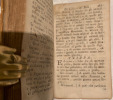TRATTORA DELLA NATURA
DE' CIBI, B DEL BERE - DI - BALDASSARE PISANELLI - Medico Bolognese - Nel quale non solomente tutti le vitu, e vizj de quelli minutamente si palesano; mo anche i rimedj per correeggere i loro difetti copiofamente s'insegnano, tan-to nell' apparecchiarli per l'ufo, quan-to nell' ordinaire il modo di riceverrli, Distinto in un vigo, e bellissimo par-tirmento tutto pieno delle dottrine de'piu celbri Medici, e Fi-losofi, con molte belle istorie natulari. - EDIZIONE SECONDA, - Dilgentemente Corretta. (a small printer's device) - IN NAPOLI ][ M.DCC.LXXXII - Nella Imprenta Severinia. Colle faculte Supreme.
1782. 4to. 153 x 90 mm. 1fep. Title page strengthened with some ink doodle on the top left corner, not affecting text. [1] 111-V111 Indice. (1)2-272. (The last page mis-numbered as p246. It should be p274, but text is correct, and another page 246 is correctly in place). 1fep. Text lightly age browned. Old vellum binding. Re-backed, with title in black ink script on spine. Faded red edges. A good copy. Text in cursive and roman type, within typographical border.
- Baldassare Pisanelli, a Bolognese doctor who practised medicine in Bologna in the 16th century. He authored a treatise on the plague and another on scorpions as well, but became celebrated through the erudition shown in this fine work of 'Trattato', dealing with the nature of comestibles. One point of reasoning, among many others, was that because birds fly, this capacity rendered them light and, consequently, easily digestible and well suited for those with delicate digestive tracks. Interestingly the sixteenth century quail was counted among the “animali volatili", that is recommended for noble consumption by Pisanelli; like other types of fowl, including capon, blackbirds, dove, pheasant, partridge, and the meat of virgin chicken (those having never laid an egg) which came to be esteemed as a noble food. Also noteworthy are the observations inspired by a hierarchical view of society; Tripe is a type of food for hard working people, young Partridges have a damaging effect only on rustic people. Pork harms sensitive and lazy people, but is suitable for people who suffer from fatigue a lot; the best way to eat it is roasted with spices. Porchette (a boned, stuffed and roasted suckling pig) usually eaten with great curiosity, should be avoided because harmful, but if the pig is of considerable age it will be a great source of nourishment. Hams and Salamis stimulate appetite but should be eaten in moderation. Medieval beliefs aside, this very interesting work on cookery and gastronomy where the author describes the qualities and uses also of fruits, vegetables (such as mushrooms, artichokes, truffles, fennel, cucumbers), fish, cheese, and more, and also gives information about the conditions under which such food and drinks should be used. The last section is devoted exclusively to wine, describing both various types of wine and the appropriate uses for each of them. The first edition published in Rome in 1583. Further editions published at Venezia and Bergamo: 1584, 1587, 1659, appear to be reprints of the first of 1583. This stated second edition of 1782 is very uncommon. Westbury p. 173; Vicarie 682; Simon 1171; Oberlè n. 70 (1st edn.); B.IN.G. 1498.





click on image to enlarge

Antiquarian category
ref number:
11336